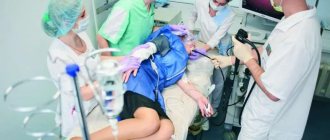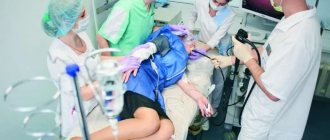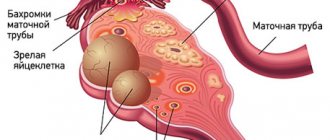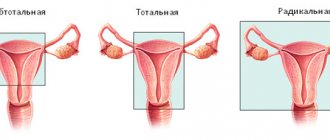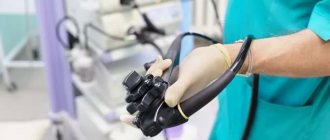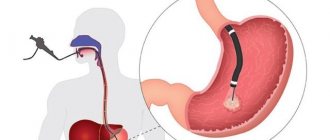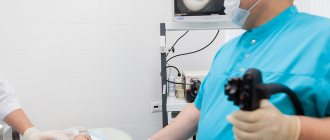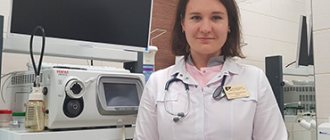What is considered stomach cancer?
Stomach cancer is a malignant neoplasm that originates from the mucous membrane of any part of the stomach. Such a tumor does not have a clear demarcation from healthy cells; it easily grows into surrounding tissues, overcomes the outer serous membrane and spreads beyond the organ. Therefore, in the later stages, a conglomerate forms in the abdominal cavity, which can involve all adjacent anatomical formations.
In addition, stomach cancer quickly grows into the walls of blood vessels and begins to spread hematogenously and lymphogenously (through the blood and lymphatic channels). Its particles settle as metastases in the lymph nodes and organs; the favorite places for such cancer screenings are the liver, lungs, brain, and in women also the ovaries.
But at the first stage, gastric cancer is limited to the mucous membrane (stage 1A) or submucosal layer (stage 1B); there are no regional or even distant metastases yet. The tumor is small, its effect on the functioning of the organ and the entire body is still insignificant. Therefore, the first signs of stomach cancer that appear do not cause significant discomfort to the patient. In most cases, they are ignored or taken for manifestations of banal gastritis or even overeating. Therefore, people with the first symptoms of stomach cancer prefer self-medication, do not consult a doctor and do not see a reason for self-examination. This leads to late detection of this terrible disease.
Stomach cancer and intestinal cancer. Benign and malignant neoplasms.
Of course, first I would like to draw your attention to the fact that modern medicine currently has many possibilities for diagnosing and removing any type of tumor.
Types of gastrointestinal tumors. (Stomach cancer, intestinal cancer)
Benign tumors do not have a harmful effect on the body, do not metastasize, and their structure consists of any type of tissue.
Malignant formations have little in common with the tissues of the body, consist of altered rapidly dividing cells and metastases and have a destructive effect on the human body.
Polyps are the most common tumors of the gastrointestinal tract. There are less dangerous polyps (mainly tumors of the upper gastrointestinal tract and are small in size). Such formations are rarely removed.
Colon polyps and their types.
Colon tumors come in different sizes and shapes and can be located in any part of the colon. Multiple large polyps carry a greater risk of developing into malignant tumors than single small formations. It is also worth noting that one of the determining factors in the danger of a polyp is its cellular component.
IMPORTANT TO REMEMBER: no matter the size, shape and cellular component of the polyp, in order to completely eliminate the risk of developing colon cancer, it must be removed.
Screening Check up. What it is?
Chek up is an examination aimed at identifying diseases in the early stages. Our center performs gastrointestinal tract screening. Specialists from CEMH (Gastrocenter) perform high-precision digital gastrocolonoscopy (gastroscopy + simultaneous colonoscopy) with simultaneous removal of polyps. The entire procedure takes place during sedation – short-term medicated sleep.
Is it possible to remove stomach cancer through an endoscope?
Surgery without an incision is a realistic method of treating cancer in the early stages, when the malignant tumor does not spread beyond the mucous or submucosal layer of the stomach.
Before such operations, the patient undergoes preliminary consultation and examination.
It is worth noting that the success of endoscopic intervention directly depends on the literacy, qualifications and, importantly, the care of the doctor. From a professional point of view, a doctor of expert level must have successful experience as a gastroenterologist-endoscopist not only in leading Russian hospitals. institutions, but also the experience of foreign internships. Particularly valued are doctors who have practical experience working in clinics in Japan, which, due to the widespread incidence of stomach cancer, is today considered the leader in the endoscopic industry. Another important factor that indicates the high qualifications of the doctor is the combination of a gastroenterologist and an endoscopist in one specialist.
In our center, gastroscopy is performed by gastroenterologist-endoscopists with extensive successful experience in leading medical institutions in Russia, Japan and a number of European countries.
Why is early diagnosis so important for stomach cancer?
Stomach cancer is a fairly common disease. Every year, just under 40 thousand new cases of this disease are diagnosed in the Russian Federation alone. Moreover, in most cases, it is detected already when the tumor tissue grows beyond the mucous membrane or even spreads beyond the organ. This greatly worsens the prognosis, makes treatment more difficult and complicated.
It is this tendency towards late diagnosis that explains the high mortality rate from stomach cancer: in terms of mortality, it ranks 2nd among all cancer diseases. And this situation, unfortunately, has remained unchanged in the Russian Federation over the last decade. In 2016, the officially registered incidence of stomach cancer was 38 thousand new cases, and the mortality rate was as much as 32 thousand! After all, the 5-year survival rate of patients with stage 3 cancer is no more than 15%.
But early diagnosis gives a completely different, much more favorable prognosis.
Among patients who consult a doctor with the first symptoms of stomach cancer, the 5-year survival rate is more than 80%. This is a very high indicator for cancer diseases affecting internal organs.
The first signs of stomach cancer: when should you be wary?
With stomach cancer, the first symptoms are in most cases local, caused by the resulting dysfunction of the organ affected by the tumor. But general nonspecific manifestations cannot be excluded. Moreover, in the initial stages of the disease they are associated not with cancer intoxication, as in advanced stages, but with anemia against the background of recurrent (repeated) gastric bleeding.
The first symptoms of stomach cancer may be:
- Discomfort in the stomach area soon after eating. The pain experienced is usually quite tolerable in intensity; many patients describe it as a feeling of fullness, unpleasant distension against the background of a small (habitual) amount of food eaten.
- The appearance of a tendency to belch, and it is usually sour in nature and is not associated with overeating.
- Increased acidity of gastric juice, which is why belching is often accompanied by a feeling of heartburn.
- Weakness, fatigue, discomfort and a tendency to random dizziness during physical activity. Typically, such complaints in case of initial stomach cancer are the first symptoms of chronic anemia that has gradually developed. Its appearance is caused by repeated small-scale bleeding from superficial vessels destroyed by the tumor. They may be accompanied by a change in the density and color of the stool, it becomes viscous and darkens. But many patients do not pay attention to this. But in many cases, such early bleeding in stomach cancer is detected only by examining stool for occult blood.
- Moderate changes in taste and food preferences, which can also be explained by the manifestation of anemia. But these symptoms are still more typical for later stages of cancer.
Some patients report slight weight loss. But in the early stages of the disease, this is not yet typical cancer cachexia (wasting), but rather a consequence of changes in appetite and a decrease in the amount of food eaten.
You can't wait. 10 questions for an endoscopist about diagnosing stomach cancer
How is stomach cancer diagnosed?
Using endoscopy.
During this procedure, the doctor examines all upper parts of the digestive tract: esophagus, stomach, duodenum. This is done using an endoscope - a special device with a camera at the end, which allows you to look inside the body and detect the smallest changes. In addition, the endoscope serves as a guide for other instruments that may be needed to, for example, immediately remove something unwanted.
My stomach doesn't bother me. Do I still need to get checked?
Absolutely, and even more so if you are already 45 years old. Malignant tumors in the stomach and intestines take 15–20 years to develop. According to statistics, in most cases, people aged 60–65 years old are diagnosed with gastrointestinal cancer—just 15–20 years after their 45th birthday.
Any inflammation in the digestive tract can transform into cancer, a process called the “Correa cascade.”
Why can't you get by with a regular ultrasound?
An ultrasound will not give the full picture. This method is suitable for diagnosing, for example, gallstones or suggesting polyps, but this is the limit of the method. With an endoscopic examination, the doctor can visualize the pathological focus, its nature and distribution.
Also, the doctor can immediately take action - remove what is needed using surgical instruments that are inserted into the body directly through an endoscope.
It hurts?
Endoscopy is unpleasant but painless. This depends on the behavior of the patient himself, his anatomy, and the size of the apparatus used for the study.
Now the study can be carried out under medical sedation. To do this, the patient is administered an ultra-short-acting hypnotic. This way the patient does not interfere with the examination with reflex movements and does not receive any unpleasant memories.
How do I know that you won’t introduce some kind of infection into my body?
Before the procedure, the endoscopic device undergoes three stages of processing: mechanical cleaning, pre-sterilization treatment and cold sterilization. Therefore, if you are afraid of an infection, it is 100% excluded.
Why did I have a biopsy during the procedure? We didn't agree on this in advance!
The doctor can take the material directly during the procedure if he detects changes in the tissues. A biopsy is the removal of cells and tissues for histological examination. Such an analysis is necessary to determine the nature of the changes detected during endoscopy, methods of treatment and further observation. The sooner the doctor understands what’s wrong with you, the better the treatment will be.
Can I have complications after the procedure?
As with any operation, complications are possible. There are two of them: bleeding and perforation. However, the likelihood of their occurrence is extremely low, and even if they start, doctors will quickly take action - stop and stitch them up.
There are practically no restrictions after the procedure. In most cases, after removal of, for example, a polyp, the patient leaves the clinic and immediately returns to his normal life.
For large polyps or if complications occur, doctors recommend observing a protective regime for three to four days and prescribing medications.
How to get to the procedure and how to understand when it’s time?
You can get the procedure by referral from a doctor or on your own. All patients with long-term and serious complaints about the gastrointestinal tract undergo such diagnostics without fail. Endoscopy is prescribed by a specialized doctor: gastroenterologist, proctologist or surgeon.
Reasons to undergo endoscopy: - secretion of latent or obvious blood in the stool, - weight loss, - anemia, - lack of appetite, - age over 45 years.
Endoscopy cannot be performed in case of acute myocardial infarction, acute cerebrovascular accident, diseases due to which the esophagus has or may be displaced (aortic aneurysm, tumors, neoplasms, etc.), etc. The doctor discusses all the pros and cons with the patient in individually.
Let's say I had an endoscopy. Does it need to be repeated?
The doctor will determine the frequency of examinations based on the results of histological examination. It could be 10 years, 3 years, 5 years, 3 months. It all depends on the results of the endoscopic examination and the morphological diagnosis, if specialists have detected any tissue changes.
Among the formations in the gastrointestinal tract, I know intestinal polyps. It is very dangerous?
Polyps are benign changes in the intestinal mucosa, one of the most common problems with the gastrointestinal tract. Their nature is not reliably clear. There are theories of both viral and genetic origin, but neither has been proven.
The main danger of polyps is that they are asymptomatic and can become malignant, that is, turn into cancer. Even then, polyps may not bother you until the cancer grows through the intestinal wall and metastasizes to other organs.
The most commonly used method for removing polyps is endoscopic mucosal resection. It is carried out directly during the study: a special loop is placed over the polyp and it is cut off within the healthy tissue. This helps prevent relapse.
In the Gastrocenter of the SMT clinic, using expert-class equipment, it is performed by doctors of the highest category. Ultra-clear cameras with multiple magnification allow you to find the smallest pathologies, just a fraction of a millimeter in size. Endoscopy is the only effective diagnosis of diseases of the stomach and intestines.
When should you see a doctor?
The first signs of stomach cancer are indistinguishable from the symptoms of indolent gastritis. Therefore, it is very difficult to independently recognize the onset of the disease, especially if the patient’s tumor appears against the background of a previous chronic pathology of the digestive tract.
The only right decision in such a situation is to consult a gastroenterologist if even small changes in the nature, intensity, duration and combination of symptoms appear. In addition, people with chronic gastroenterological diseases are recommended to undergo regular preventive examinations. This will help monitor the condition of the gastric mucosa and identify malignant tumors at stage 1 or even 0 (precancerous) when they are still a small superficial island of cells.
How to diagnose stomach cancer
General clinical blood tests and comparison of symptoms in the first stages of stomach cancer will not provide reliable information. The presence of a malignant tumor can only be confirmed by histological examination of tissue obtained by biopsy of areas suspicious for a tumor. Therefore, the gold standard for diagnosing stomach cancer is FGS (fibrogastroscopy).
This technique cannot be replaced by any other visualization method. After all, it is FGS that allows the doctor to examine the gastric mucosa, where cancer cells originate, in real time and with magnification. A biopsy makes it possible to confirm the diagnosis histologically, which is the only absolutely reliable method for diagnosing cancer.
According to modern clinical guidelines, patients with an increased risk of developing gastric cancer should undergo FGS once a year. Moreover, the slightest suspicion of cancer pathology in the form of the appearance of new symptoms or changes in the nature of existing ones is a clear reason for an unscheduled examination.
Symptoms
The early stages of gastric cancer are characterized by an abundance of paraneoplastic symptoms, often masking the development of the tumor and leading away from the correct diagnosis.
- One of the most striking symptoms is acanthosis nigricans, in which dark pigmentation of the skin of the armpits and other large skin folds develops, accompanied by villous-warty growths. Sometimes acanthosis nigricans precedes the manifestations of the tumor itself by several years.
- Polymyositis, dermatomyositis, ring-shaped erythema, pemphigoid, and severe seborrheic keratosis that is not inferior to treatment also require an in-depth examination with mandatory endoscopy of the stomach.
- There are cases when the production of glucocorticoid hormones by tumor cells, which are normally synthesized by the adrenal glands, even causes the formation of the so-called. ectopic Cushing's syndrome. With it, adipose tissue is deposited mainly on the face and abdomen (so-called matronism), blood pressure rises, and a tendency to bone fractures and acne develops.
- A frequent paraneoplastic manifestation of gastric cancer, like many other tumors, is migrating thrombophlebitis (Trousseau's syndrome).
- It is most difficult to suspect the development of stomach cancer when dementia suddenly begins to progress rapidly in older people, or when there is a lack of coordination of movements, a change in gait, or an imbalance.
to get a consultation
The situation is aggravated by the similarity of the clinical, radiological and endoscopic picture of ulcerated tumors and peptic ulcer disease. Therefore, the most sensitive diagnostic method is considered to be esophagogastroduodenoscopy (EGD, gastroscopy) with multiple biopsies , which are mandatory in patients at risk. EGDS allows you to simultaneously:
- perform a biopsy and conduct further histological and cytological examination for the purpose of morphological verification of the tumor and diagnosis;
- carry out therapeutic manipulations for coagulation of the polyp with its removal in small sizes (up to 2 cm);
- stop the bleeding;
- insert a feeding tube, etc.
If there is a risk of bleeding, a less traumatic brush biopsy is used. In doubtful cases, a repeat biopsy is prescribed after 8-12 weeks. But even this diagnostic method gives the correct answer only in 90% of cases and can give a false negative result with infiltrative tumor growth (such cancer is called scirrhus).
In addition to cancer, tumors from other cells can also develop in the stomach, requiring completely different approaches to treatment (sarcoma, lymphoma). The only way to figure this out is through multiple biopsies during EGD. To identify altered areas of tissue that are not detected during normal examination, the so-called. chromogastroscopy. This method makes it possible to diagnose tumors in the early stages due to the fact that when the gastric mucosa is stained during the procedure with special dyes (Congo blue/methylene blue, indigocamine) and even Lugol's solution, tumor tissues look different from healthy ones.

Where to take the FGS
FGS is not an innovative or rare diagnostic technique; many medical institutions offer services for such examination. But if possible, preference should still be given to specialized centers equipped with the most modern models of endoscopic devices.
ICLINIC is a multidisciplinary clinic on which the Digestive System Cancer Prevention Center operates. Therefore, ICLINIC specialists have extensive clinical experience in identifying the earliest signs of malignancy (malignancy) of the gastric mucosa. And the latest models of fiber gastroscopes with high-precision optical systems, atraumatic small-diameter tubes and sensitive manipulators allow the examination to be carried out precisely, quickly, with a high degree of reliability and at the same time with minimal discomfort for the patient.
How is FGDS performed?
The procedure involves swallowing a flexible endoscope with a diameter of about 1 cm. For children, it is suggested to use a probe of a smaller diameter. Nowadays, an ocular endoscope and probe equipped with a miniature video camera are used. A video endoscope is the most advanced device that gives the doctor the following advantages:
- high-quality color picture on the monitor (increased clarity and higher magnification);
- dynamic recording;
- saving video examination.
5 minutes before the procedure, the doctor administers local anesthesia (treats the throat with lidocaine). For children and especially agitated patients, FGDS is sometimes performed under sedation (a medicinal substance is administered that puts the subject into a short-term sleep). The patient is placed on the couch on his left side. Place a towel on the pillow under your head; saliva will then flow onto it.
Next, the patient is asked to clamp the plastic ring with his teeth, and an endoscope is advanced into its hole to the root of the tongue. The doctor asks the patient to make swallowing movements, during which the probe moves along the esophagus into the stomach. It is this moment (takes only a few seconds) that is most unpleasant and can cause a gag reflex.
When the video camera reaches the stomach, the compressor pumps air into it (straightens the collapsed walls of the empty stomach), the remaining liquid (mucus, bile, gastric juice) is extracted using an electric suction and an examination of its mucous membrane begins. Using an endoscope, the endoscopist examines the walls of the stomach, esophagus and duodenum.
Test for the probability of stomach cancer
Are you over 45 years old?
Did your relatives have cancer?
You have chronic diseases of the gastrointestinal tract: - chronic gastritis, - peptic ulcer, - chronic colitis and other inflammatory bowel diseases, - Crohn's disease, - ulcerative colitis, - previously identified polyps of the stomach and intestines, - identified submucosal epithelial formations of the gastrointestinal tract -intestinal tract?
Have you had surgery on the stomach and intestines?
Do you have scar-adhesive changes in the gastrointestinal tract?
Do you smoke (more than 1 cigarette per day)?
Do you make mistakes in your diet (low consumption of vegetables and fruits, high consumption of meat and animal fats)?
When is EGDS (gastroscopy) necessary?
There are diseases that are considered precancerous and require periodic examination regardless of the presence of symptoms. These include:
- chronic atrophic gastritis with the so-called intestinal metaplasia, especially in the presence of Helicobacter pylori infection;
- stomach ulcer;
- Barrett's esophagus;
- vitamin B12 deficiency (pernicious anemia);
- adenomatous polyps of the stomach;
- hypertrophic gastropathy.
Stomach operations due to benign tumors, undergone more than 10 years ago, and family history are also situations that require close monitoring.
You should be regularly monitored with mandatory regular endoscopy if your relatives have been diagnosed with:
- cancer of the gastrointestinal tract,
- familial adenomatous polyposis of the colon,
- Gardner syndrome,
- Peutz-Jeghers syndrome,
- familial juvenile polyposis,
- Li Fraumeni syndrome.
With the development of genetics, certain genes have become known, certain mutations of which, under special conditions, lead to stomach cancer.
There are also regions in which, apparently as a result of nutritional or environmental characteristics, the incidence is significantly higher than average (Japan, some European countries, Scandinavia, South and Central America, China, Korea, countries of the former USSR). People who live in these areas for a long time need to be more attentive to their health and periodically undergo endoscopy. A signal for mandatory examination can be an indicator such as the concentration of pepsinogen in the blood serum (normally less than 70 ng/ml) and the ratio of its fractions (PG1/PG2).
If it is impossible to conduct endoscopy, for example, due to concomitant diseases, polyposition radiography with double contrast with barium suspension and air can be performed. This method, however, is much less sensitive in the early stages of the disease and does not allow morphological verification. Additionally, MSCT and ultrasound are used, however, the accuracy of the latter study, even with an experienced researcher, is very dependent on the technical capabilities of the device, body type and correct preparation of the patient.
Get a treatment program
